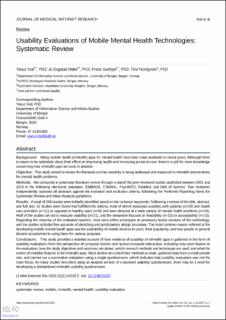| dc.contributor.author | Inal, Yavuz | |
| dc.contributor.author | Wake, Jo Dugstad | |
| dc.contributor.author | Guribye, Frode | |
| dc.contributor.author | Nordgreen, Tine | |
| dc.date.accessioned | 2021-05-06T09:46:14Z | |
| dc.date.available | 2021-05-06T09:46:14Z | |
| dc.date.created | 2019-11-05T09:58:23Z | |
| dc.date.issued | 2020 | |
| dc.Published | Journal of Medical Internet Research. 2020, 22:e125337 (1), 1-19. | |
| dc.identifier.issn | 1438-8871 | |
| dc.identifier.uri | https://hdl.handle.net/11250/2753889 | |
| dc.description.abstract | Background: Many mobile health (mHealth) apps for mental health have been made available in recent years. Although there is reason to be optimistic about their effect on improving health and increasing access to care, there is a call for more knowledge concerning how mHealth apps are used in practice. Objective: This study aimed to review the literature on how usability is being addressed and measured in mHealth interventions for mental health problems. Methods: We conducted a systematic literature review through a search for peer-reviewed studies published between 2001 and 2018 in the following electronic databases: EMBASE, CINAHL, PsycINFO, PubMed, and Web of Science. Two reviewers independently assessed all abstracts against the inclusion and exclusion criteria, following the Preferred Reporting Items for Systematic Review and Meta-Analysis guidelines. Results: A total of 299 studies were initially identified based on the inclusion keywords. Following a review of the title, abstract, and full text, 42 studies were found that fulfilled the criteria, most of which evaluated usability with patients (n=29) and health care providers (n=11) as opposed to healthy users (n=8) and were directed at a wide variety of mental health problems (n=24). Half of the studies set out to evaluate usability (n=21), and the remainder focused on feasibility (n=10) or acceptability (n=10). Regarding the maturity of the evaluated systems, most were either prototypes or previously tested versions of the technology, and the studies included few accounts of sketching and participatory design processes. The most common reason referred to for developing mobile mental health apps was the availability of mobile devices to users, their popularity, and how people in general became accustomed to using them for various purposes. Conclusions: This study provides a detailed account of how evidence of usability of mHealth apps is gathered in the form of usability evaluations from the perspective of computer science and human-computer interaction, including how users feature in the evaluation, how the study objectives and outcomes are stated, which research methods and techniques are used, and what the notion of mobility features is for mHealth apps. Most studies described their methods as trials, gathered data from a small sample size, and carried out a summative evaluation using a single questionnaire, which indicates that usability evaluation was not the main focus. As many studies described using an adapted version of a standard usability questionnaire, there may be a need for developing a standardized mHealth usability questionnaire. | en_US |
| dc.language.iso | eng | en_US |
| dc.publisher | JMIR Publications | en_US |
| dc.relation.uri | https://www.jmir.org/2020/1/e15337/ | |
| dc.rights | Navngivelse 4.0 Internasjonal | * |
| dc.rights.uri | http://creativecommons.org/licenses/by/4.0/deed.no | * |
| dc.title | Usability evaluations of mobile mental health technologies: A systematic review study | en_US |
| dc.type | Journal article | en_US |
| dc.type | Peer reviewed | en_US |
| dc.description.version | publishedVersion | en_US |
| dc.rights.holder | Copyright 2020 The Authors | en_US |
| dc.source.articlenumber | e15337 | en_US |
| cristin.ispublished | true | |
| cristin.fulltext | original | |
| cristin.qualitycode | 2 | |
| dc.identifier.doi | 10.2196/15337 | |
| dc.identifier.cristin | 1744060 | |
| dc.source.journal | Journal of Medical Internet Research | en_US |
| dc.source.40 | 22:e125337 | |
| dc.source.14 | 1 | |
| dc.relation.project | Norges forskningsråd: 259293 | en_US |
| dc.relation.project | Norges forskningsråd: 283259 | en_US |
| dc.identifier.citation | Journal of Medical Internet Research. 2020;22(1):e15337 | en_US |
| dc.source.volume | 22 | en_US |
| dc.source.issue | 1 | en_US |

